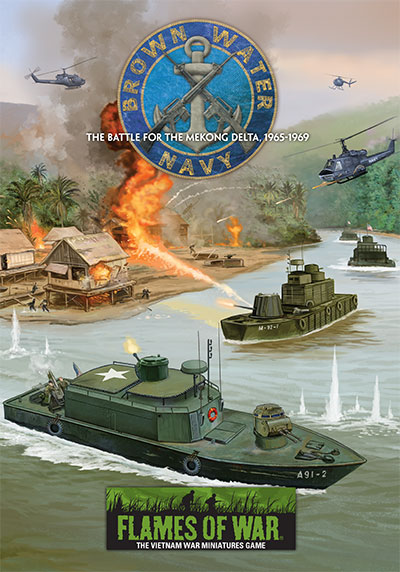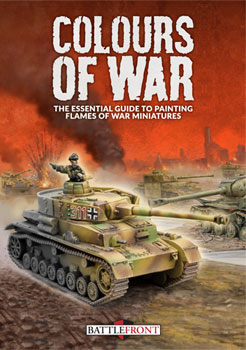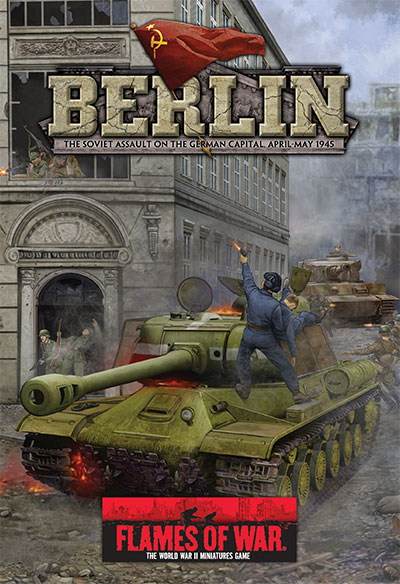In this third and final installment tracing 654. Schwere Panzerjäger-Abteilung through
World War II in Flames of War, we look at the unit in the Late War period (Part 1 covers Early War, while Part 2 covers Mid War).
Fortunately actually fielding the unit is far easier in Late War as there are
numerous lists covering its deployment. After surrendering their Ferdinand tank
destroyers after the battle of Kursk and the Soviet counteroffensives, the unit
spent the next several months in rear areas training while their new mount, the
Jagdpanther tank destroyer, was readied. The first eight of these vehicles didn’t
arrive until March 4, 1944, and training in the new vehicles began immediately.
Deliveries of the new vehicle were slow, and the unit was
deployed to Normandy with only its eight original vehicles reaching the front
by the end of June. The remainder of the unit’s 25 vehicles didn’t arrive at
the training camp until the first of July, and by the end of the month the unit
was in some sort of order. The unit also
received a few Panther tanks as command vehicles. Finally fighting as a unit,
and despite the mechanical fragility of the new vehicle, the unit took a heavy
toll on Allied armor destroying over 40 Allied tanks near Caen fighting
alongside units like 276. and 326. Infanteriedivision as well as a
part of Kampfgruppe Schnepf. However,
despite their best efforts, the lines in Normandy couldn’t hold, and the unit
was forced to abandon most of its vehicles at the Seine in the general retreat.
Atlantik Wall
has a dedicated list covering 654. Schwere
Panzerjäger-Abteilung along with several other lists which can take the
unit as a support choice. This gives the player a great deal of flexibility in
fielding the force.
Opposing the Normandy Breakout – 654. Schwere
Panzerjäger-Abteilung – July through September, 1944
Schwere Panzerjägerkompanie – Atlantik Wall p. 136
·
Compulsory:
As required by list – if you want to model the early battles before the
entire Abteilung is outfitted with
the Jagdpanther, take the Panther A option as HQ – for the later battles stick
with the Jagdpanther (early) tank destroyers.
·
Historical Flavor:
o Any
of the support options for this list are fine as the list is specifically
designed to represent 654. Schwere Panzerjäger-Abteilung.
It’s up to you if you want to try and stay historical in your support choices
(as in when the unit would be supporting an infantry division or other unit)
Grenadierkompanie – Atlantik
Wall p. 140 – or Pionierkompanie – Atlantik
Wall p. 144
·
Compulsory:
As required by list – in this case rather than taking the unit itself,
you’d be using the unit to support an infantry company from units like 276. and 326. Infanteriedivision
·
Add 654. Schwere
Panzerjäger-Abteilung: Add the
Jagdpanther Platoon on page 137
Now that you can truly base a list around the unit, there
are some fun modeling projects you can do with the unit. You’ll need the
version of the Jagdpanther with zimmerit to properly model 654. Schwere Panzerjäger-Abteilung at this time. Unfortunately the
boxed set of three Jagdpanthers with zimmerit (GBX41) is no longer available and Battlefront instead recommends the new plastic
Jagdpanther (which is flat out wrong and isn’t a substitution for the early
model because the plastic Jagdpanther is a late version without zimmerit, among
other important cosmetic differences). That
means you have to go the fairly expensive route of picking up several
Jagdpanther (GBX22) sets with the ruined building. Which is a nice little terrain piece in its
own right, but it add unnecessary expense if all you want is a few of the right
Jagdpanthers. Hopefully you’ll be able to find some in the secondary market or
at your Favorite Local Gaming Store!
As the first production Jagdpanthers went to 654 Schwere Panzerjäger-Abteilung, the
unit had a mix of the monobloc and two-piece barrels. If you’re modeling the
unit early on, be sure to take the opportunity to fix-up the barrels of the
Jagdpanthers so they have that distinctive monobloc look. I did that on my
Jagdpanthers for 559 Schwere
Panzerjäger-Abteilung a while back. If you get the version of the miniature
with the plastic barrel (or pick up the Plastic Panther Sprue (GSO199) and use it for the gun barrels (and tracks – do yourself a favor and use the
plastic tracks – they are excellent!). For
the Normandy campaign, the unit’s vehicles were generally painted in a 3 tone “wide-band”
camouflage scheme. The unit used the standard national markings on the sides
and to the rear of that a normal 3-digit vehicle number in red with white
outline. The Panthers appear to have
been in a band scheme as well (though the red and green are separate in artist’s
renderings) – and at least one was number 002 (red with white outline), I
believe the other was 001. There may have been one Jagdpanther in overall dark
yellow, but that is unconfirmed.
Operation Nordwind
Through October 654. Schwere Panzerjäger-Abteilung was in a period of rebuilding, but by
November 20th, the unit was back up to strength. Hitler committed
the unit to Operation Nordwind. For this
battle, 525. Schwere Panzerjäger-Abteilung
and its Hornisse tank destroyers were attached to the unit. The fighting in
Alsace was a vicious back-and-forth affair, but by the end of the action, the
unit had destroyed over 100 Allied tanks. After Nordwind, the Hornisse were
removed, and the unit continued serve as a fire brigade for the next several
weeks, but by February 8, 1945 the unit Jagdpanthers had once again been lost.
I had the privilege of writing up the German lists and
history for the Bridge at Remagen book, and it
includes a list designed specifically to represent the unit during the Nordwind
offensives. The list is pretty much a standalone list with no other lists that
can choose it in support, but it does allow you to field the unique combination
of Jagdpanther and Hornisse as combat platoons in the same army.
Operation Nordwind and the Aftermath – 654. Schwere
Panzerjäger-Abteilung – December 23, 1944 through February 8, 1945
654. Schwere Panzerjäger-Kompanie (Nordwind) – Bridge at Remagen p. 54
·
Compulsory:
As required by list. You’re free
to include or skip the Hornisse platoon – either way is accurate, though the
Hornisse were detached before the unit lost all of its Jagdpanthers.
·
Historical Flavor:
o Any
of the support options for this list are fine as the list is specifically
designed to represent 654. Schwere Panzerjäger-Abteilung
Modeling this particular version of the unit is in some
ways the most difficult of the three eras when the unit is equipped with
Jagdpanther because Battlefront makes no miniature (and has never made
miniatures) that are 100% appropriate for the vehicles used by the Abteilung during this time frame. By and
large the vehicles are all Jagdpanthers without zimmerit – generally in a wide
or narrow band style camouflage marked with national crosses and three digit
vehicles numbers (red with white outline) as before. The unit appeared to get a
fairly scruffy whitewash before the Nordwind offensive.
The new Panther/Jagdpanther Platoon (Plastic) (GBX84) is really a “final production” version of this vehicle rather than the “mid”
production version of the vehicle. The mid production vehicle didn’t have the
raised cooling fan on the engine deck, and used the earlier style exhausts
(which come in the kit – you’ll probably want to put the rounded shield over
the middle portion of the exhaust). They also all had the stowage bin to the
left of the hull rear hatch (as viewed from the rear). The gun cleaning rod
tube was relocated from the side to the back of the engine deck (which is easy
to do as it is a separate piece in the kit). If you want a 100% accurate
representation, steal one of the engine deck screens from the Panther hull and
donate it to the Jagdpanther once you’ve shaved the raised one down. The
required stowage box is on the sprue with the tracks. One can’t rule out that some earlier versions
were also in use, so feel free to mix and match a little bit.
Ruhr Pocket to the End
The unit ended the war in the Ruhr pocket being deployed
to the area in late February, 1945. Initially
the unit fought as a part of Schwere
Panzergruppe Hudel. Unfortunately recreating the army during this period is
hard to accomplish at modest point values as to best represent the force you’ll
want to take a 512. Schwere Panzerjäger
Platoon (reluctant trained – the confident veteran company did not fight
with the Kampfgruppe), Schwere Panzer Platoon, or Schwere Tiger I E Platoon in
support. Any of these choices will eat
up a lot of points, so you may have to pare back your compulsory choices. Fortunately the RT list only requires one 654. Schwere Panzerjäger Platoon, making
the list at least mathematically viable. Historically the Kampfgruppe was
supported by infantry and a few militia (represented by the Volkssturm
options).
By mid-March, the unit had been detached from the Kampfgruppe and reassigned to support
11. Panzer Division. By this time, the only armored support platoons that are
representative would be the Panzer Platoon. The infantry choices, again, appear
to all be reasonably valid for this short period of time between March 16 and
18.
On March 19, the 654th was released from 11.
Panzer Division, and was essentially on its own. To best represent the force
during this period, the only armored formation that should be taken in support
would be the Panzer platoon, though one could argue with the withdrawal of 11.
Panzer Division, any armored assets apart from the unit’s own Jagdpanthers
would be rare. On April 15, 654. Schwere Panzerjäger Abteilung had
expended its last in a desperate bid to stop the American advance. With its
fighting strength reduced to effectively zero, the unit surrendered ending its
participation in the Second World War.
The Bridge at Remagen
book has a list for this incarnation of the force on page 55 for the various
desperate battles in the Ruhr pocket. Writing this list was particularly
challenging because formations were being created, disbanded, redeployed, and
recreated at a dizzying rate.
Ruhr Pocket – February 21 – March 10, 1945 – in transit –
technically attached to 5. Panzer Armee
Ruhr Pocket - Schwere Panzergruppe Hudel – March 11-15,
1945 – Remagen p 55.
·
Compulsory:
RV 654. Schwere Panzerjägerkompanie HQ + one RV 654. Schwere Panzerjäger
Platoon
·
Historical Flavor: 512. Schwere Panzerjäger Platoon (RT),
Schwere Panzer Platoon or Schwere Tiger I E Platoon
·
Not appropriate for this time period: Panzer Platoon
·
Appropriate Support: Any allowable by list
Ruhr Pocket – Attached to 11. Panzer Division – March
15-19, 1945 – Remagen p 55.
·
Compulsory:
RV 654. Schwere Panzerjägerkompanie HQ + one RV 654. Schwere Panzerjäger
Platoon
·
Historical Flavor: Panzer Platoon
·
Not appropriate for this time period: 512. Schwere Panzerjäger Platoon (RT),
Schwere Panzer Platoon or Schwere Tiger I E Platoon
·
Appropriate Support: Any allowable by list
Ruhr Pocket – During the collapse of the Pocket – March
19 – April 15, 1945 – Remagen p 55.
·
Compulsory:
RV 654. Schwere Panzerjägerkompanie HQ + one RV 654. Schwere Panzerjäger
Platoon
·
Possible, but unlikely: Panzer Platoon
·
Not appropriate for this time period: 512. Schwere Panzerjäger Platoon (RT),
Schwere Panzer Platoon or Schwere Tiger I E Platoon
·
Appropriate Support: Any allowable by list
Modeling the unit during this timeframe is fairly easy –
though some fun can be had with it. Most of the vehicles will be new production
late Jagdpanthers, pretty much what you get in the Panther/Jagdpanther Platoon
(Plastic) (GBX84) box. Photographic evidence suggests some will have the stowage bin on the
hull rear, others won’t. Most of these vehicles have the gun cleaning rod at
the back of the engine deck and will have the cylindrical exhausts as provided
in the kit. Interestingly, at least a few still retained the “side pipes” even
with the cylindrical exhaust. There is also photographic evidence of at least
one early production Jagdpanther, with zimmerit, a two-piece gun barrel, and
the gun cleaning tube moved to the rear of the engine deck that served with the
unit during this time. This vehicle had likely been factory refurbished and
sent back to the front alongside the new-production vehicles. In general all of the vehicles were in a three
tone scheme – though some vehicles carried the vehicle number below the
national insignia, and at least one vehicle carried the national insignia on
the front of the vehicle. Below is an extant color photo of one of the vehicles
from this time period knocked out near Winterberg – bear in mind the color isn’t
going to be “true” by modern standards, but it gives you a good idea of what
these awesome vehicles actually looked like. Granted this one is a bit worse for wear!.
Thus ends the combat history of 654. Schwere Panzerjäger Abteilung from its humble beginnings as a
towed 3.7cm anti-tank gun battalion, through its use of the Ferdinand and later
Jagdpanther tank destroyers. A unit with such a long and diverse combat history
provides many opportunities for the Flames of War player to experiment with
units and unify the three game periods. Hopefully you’ve enjoyed this series –
let me know if you have any other units you’d like to see in the comments – and
no, the next one WON’T be Grossdeutschland,
but I’d love to actually do that one some day!








